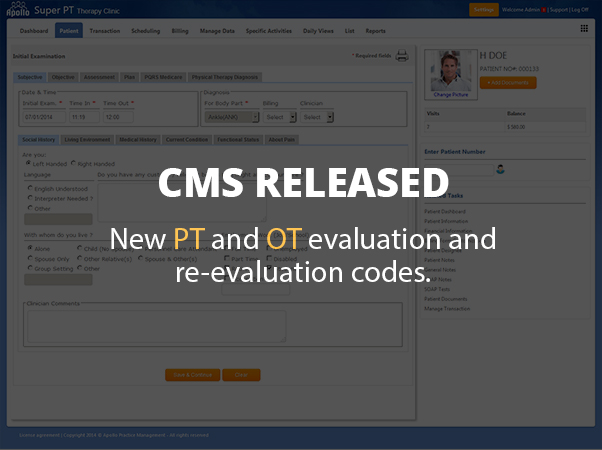 On July 7, CMS released information on the proposed new PT and OT evaluation and re-evaluation codes. CMS will finalize these codes and their reimbursement levels in November to be effective January 1, 2017.
On July 7, CMS released information on the proposed new PT and OT evaluation and re-evaluation codes. CMS will finalize these codes and their reimbursement levels in November to be effective January 1, 2017.
There are three proposed PT eval codes, three OT eval codes, and one new re-eval code for each discipline which replace codes 97001 through 97004. While there are three evaluation codes, one each for low complexity, moderate complexity and high complexity, CMS is proposing that they all be valued the same, and hence reimbursement will be the same for all three. The proposed unit values and reimbursement will be very similar, if not the same, as the current eval and re-eval codes. You can count on that once CMS obtains enough data about the usage of these codes, they may adjust their values in later years.
CMS is says “the following codes are misvalued”: 97032 e-stim, 97035 ultrasound therapy, 97110 therapeutic exercises, 97112 neuromuscular re-ed, 97113 aquatic therapy/exercises, 97116 gait training, 97140 manual therapy, 97530 therapeutic activities, 97535 self care management training, G0283 elec stim other than wound care. This means these codes are used too much or are paid out at to high of a value
The table below shows the proposed PT and OT codes and their descriptors.
| New PT & OT CPT Eval & Re-Eval Codes | CPT Long Form Descriptors for Physical Medicine and Rehabilitation |
| 97X61 | Physical therapy evaluation: low complexity, requiring these components:
Typically, 20 minutes are spent face-to-face with the patient and/or family. |
| 97X62 | Physical therapy evaluation: moderate complexity, requiring these components:
|
| 97X63 | Physical therapy evaluation: high complexity, requiring these components:
|
| 97X64 | Reevaluation of physical therapy established plan of care, requiring these components:
|
| 97X65 | Occupational therapy evaluation, low complexity, requiring these components:
|
| 97X66 | Occupational therapy evaluation, moderate complexity, requiring these components:
|
| 97X67 | Occupational therapy evaluation, high complexity, requiring these components:
|
| 97X68 | Reevaluation of occupational therapy established plan of care, requiring these components:
|

